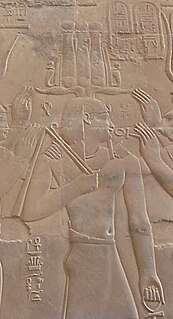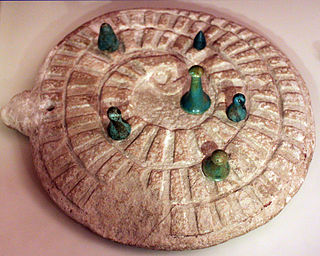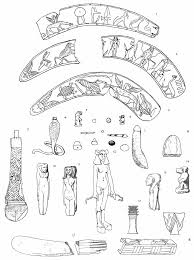 W
WAncient Egyptian pottery includes all objects of fired clay from ancient Egypt. First and foremost, ceramics served as household wares for the storage, preparation, transport, and consumption of food, drink, and raw materials. Such items include beer and wine mugs and water jugs, but also bread molds, fire pits, lamps, and stands for holding round vessels, which were all commonly used in the Egyptian household. Other types of pottery served ritual purposes. Ceramics are often found as grave goods.
 W
WAncient furniture was made of many different materials, including reeds, wood, stone, metals, straws, and ivory. Some civilizations used inlay or they carved images of mythological creatures and constellations into their furniture. Occasionally furniture would be inlaid into a certain shape. For example, the game Mehen was played on a table inlaid into the shape of a snake. Inlays were also used to ornament shapes. Chairs would be stylized with metals, finials, inlays, or upholstery. It was a common practice for the legs of furniture to be shaped like animal legs and use mortise and tenon joints. Lacquerware and Ivory carving were also common.
 W
WAnimal mummification was common in ancient Egypt. They mummified various animals. It was an enormous part of Egyptian culture, not only in their role as food and pets, but also for religious reasons. They were typically mummified for four main purposes—to allow beloved pets to go on to the afterlife, to provide food in the afterlife, to act as offerings to a particular god, and because some were seen as physical manifestations of specific deities that the Egyptians worshipped. Bastet, the cat goddess, is an example of one such deity. In 1888, an Egyptian farmer digging in the sand near Istabl Antar discovered a mass grave of felines, ancient cats that were mummified and buried in pits at great numbers.
 W
WIn ancient Egypt the bee was an insignia of kingship associated particularly with Lower Egypt, where there may even have been a Bee King in pre-dynastic times.
 W
WAncient Egyptian clothes refers to clothing worn in ancient Egypt from the end of the Neolithic period to the collapse of the Ptolemaic Kingdom with the death of Cleopatra in 30 BC. Egyptian clothing was filled with a variety of colors. Adorned with precious gems and jewels, the fashions of the ancient Egyptians were made for not only beauty but also comfort. Egyptian fashion was created to keep cool while in the hot desert.
 W
WThe cuisine of ancient Egypt covers a span of over three thousand years, but still retained many consistent traits until well into Greco-Roman times. The staples of both poor and wealthy Egyptians were bread and beer, often accompanied by green-shooted onions, other vegetables, and to a lesser extent meat, game and fish.
 W
WDancing played a vital role in the lives of the ancient Egyptians. However, men and women are never depicted dancing together. The trf was a dance performed by a pair of men during the Old Kingdom. Dance groups were accessible to perform at dinner parties, banquets, lodging houses, and even religious temples. Some women from wealthy harems were trained in music and dance. They danced for royalty accompanied by male musicians playing on guitars, lyres, and harps. Yet, no well-bred Egyptian would dance in public, because that was the privilege of the lower classes. Wealthy Egyptians kept slaves to entertain at their banquets and present pleasant diversion to their owners.
 W
WEgyptian hieroglyphs were the formal writing system used in Ancient Egypt, used for writing the Egyptian language. Hieroglyphs combined logographic, syllabic and alphabetic elements, with a total of some 1,000 distinct characters. Cursive hieroglyphs were used for religious literature on papyrus and wood. The later hieratic and demotic Egyptian scripts were derived from hieroglyphic writing, as was the Proto-Sinaitic script that later evolved into the Phoenician alphabet. Through the Phoenician alphabet's major child systems, the Egyptian hieroglyphic script is ancestral to the majority of scripts in modern use, most prominently the Latin and Cyrillic scripts and the Arabic script and possibly Brahmic family of scripts.
 W
WThe Eye of Horus, wedjat eye or udjat eye is a concept and symbol in ancient Egyptian religion that represents well-being, healing, and protection. It derives from the mythical conflict between the god Horus with his rival Set, in which Set tore out or destroyed one or both of Horus's eyes and the eye was subsequently healed or returned to Horus with the assistance of another deity, such as Thoth. Horus subsequently offered the eye to his deceased father Osiris, and its revivifying power sustained Osiris in the afterlife. The Eye of Horus was thus equated with funerary offerings, as well as with all the offerings given to deities in temple ritual. It could also represent other concepts, such as the moon, whose waxing and waning was likened to the injury and restoration of the eye.
 W
WHead cones, also known as perfume cones or wax cones were a type of conical ornament worn atop the head in ancient Egypt. They are often depicted on paintings and bas-reliefs of the era, but were not found as archaeological evidence until 2019.
 W
WThe heart scarab is an oval, scarab artifact dating from ancient Egypt. Mostly an amulet, it was also used as jewelry, a memorializing artifact, or a grave good. The heart scarab was used by referring to Chapter 30 from the Book of the Dead and the weighing of the heart, being balanced by Maat, goddess of truth, justice, order, wisdom, and cosmic balance. The function of the heart scarab was to bind the heart to silence while it was being weighed in the underworld to ensure that the heart did not bear false witness against the deceased. As in many current religions, the individual had to show 'worthiness' to achieve the afterlife. The heart was extremely important to ancient Egyptians as the seat of intelligence and the storehouse of memory. It was the only organ left in place during mummification. Heart scarab amulets were meant as substitutes for the heart should the deceased be deprived of the organ in the afterlife. For example, when a person died, a heart scarab was often placed on their heart and bound underneath the bandages of the mummy. This was to ensure that it could not be physically removed from their person.
 W
WHemhem crown was an ancient Egyptian ceremonial headgear. It was basically an ornate triple atef with corkscrew sheep horns and usually two uraei. The Egyptian word "hemhem" means "to shout", "cry out", possibly indicating that the hemhem crown represented a battle horn.
 W
WThe ancient Egyptians were one of the first cultures to widely divide days into generally agreed-upon equal parts, using early timekeeping devices such as sundials, shadow clocks, and merkhets . Obelisks are used by reading the shadow that it makes. The citizens could divide the day into two parts, and then into smaller hours.
 W
WHounds and jackals is the modern name given to an ancient Egyptian game that is known from several examples of gaming boards and gaming pieces found in excavations. The modern game was discovered by Howard Carter, who found one complete gaming set in a Theban tomb of ancient Egyptian pharaoh Amenemhat IV that dates to the 12th Dynasty. The latter game set is one of the best preserved examples and is today in the Metropolitan Museum of Art in New York. He called it "Hounds contra Jackals". Another, less often used modern name is "fifty-eight holes".
 W
WHyphaene thebaica, with common names doum palm and gingerbread tree, is a type of palm tree with edible oval fruit. It is a native to the Arabian Peninsula and also to the northern half and western part of Africa where it is widely distributed and tends to grow in places where groundwater is present.
 W
WThe medicine of the ancient Egyptians is some of the oldest documented. From the beginnings of the civilization in the late fourth millennium BC until the Persian invasion of 525 BC, Egyptian medical practice went largely unchanged and included simple non-invasive surgery, setting of bones, dentistry, and an extensive set of pharmacopoeia. Egyptian medical thought influenced later traditions, including the Greeks.
 W
WMehen is a board game which was played in ancient Egypt. The game was named in reference to Mehen, a snake deity in ancient Egyptian religion.
 W
WThe merkhet or merjet was an ancient surveying and timekeeping instrument. It involved the use of a bar with a plumb line, attached to a wooden handle. It was used to track the alignment of certain stars called decans or "baktiu" in the Ancient Egyptian. When visible, the stars could be used to measure the time at night. There were 10 stars for the 10 hours of the night; the day had a total of 24 hours including 12 hours for the day, 1 hour for sunset, and 1 hour for sunrise. Merkhets were used to replace sundials, which were useless during the dark.
 W
WIn Ancient Egyptian society, hair was an embodiment of identity. It could carry religious and erotic significance and portray information about gender, age, and social status. During the New Kingdom, more elaborate hairstyles for men and women, incorporating curls and plaits, began to be favored over the traditional, simple hairstyles of the Old and Middle Kingdoms.
 W
WThe Ramesseum magician's box is a container discovered in 1885–1886 in a tomb underneath the Ramesseum by Flinders Petrie and James Quibell, containing papyri and items related to magical practices.
 W
WThe Scarab ring is a style of finger ring featuring a small sculpture of a scarab as the bezel that was popular in the Egyptian Middle Kingdom and later. They generally incorporated an inscription on the base of the scarab but not always.
 W
WA scribe is a person who serves as a professional copyist, especially one who made copies of manuscripts before the invention of automatic printing.
 W
WSenet is a board game from ancient Egypt. The earliest representation of senet is dated to c. 2620 BCE from the Mastaba of Hesy-Re, while similar boards and hieroglyphic signs are found even earlier. The game fell out of use following the Roman period, and its original rules are the subject of conjecture.
 W
WSenet is a board game from ancient Egypt. The earliest representation of senet is dated to c. 2620 BCE from the Mastaba of Hesy-Re, while similar boards and hieroglyphic signs are found even earlier. The game fell out of use following the Roman period, and its original rules are the subject of conjecture.
 W
WThe sidelock of youth was an identifying characteristic of the child in Ancient Egypt. It symbolically indicates that the wearer is a legitimate heir of Osiris. The sidelock was used as a divine attribute from at least as early as the Old Kingdom.
 W
WThe ancient Egyptians believed that a soul was made up of many parts. In addition to these components of the soul, there was the human body.